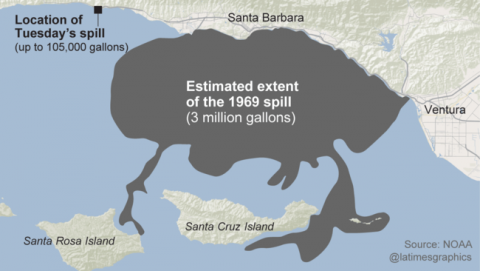On January 28, 1969, a blowout occurred at an oil-rig platform just off the Santa Barbara coast. The disaster had one good outcome—it is credited with ushering in the modern environmental movement.
This map image, using data from NOAA (the National Oceanic and Atmospheric Administration) depicts the extent of the spill.
NOAA provides details about the event and its aftermath, including significant economic damage:
On January 28, 1969, the Union Oil Company well number 21 under Platform A, located 5.5 miles southeast of Santa Barbara, California, in the Dos Cuadras field, experienced a blowout while drill bits were being changed. A massive mixture of oil, gas, and drilling mud roared up the drill casing and spewed out onto the platform.
Well A-21 was capped on February 7 with 13,000 barrels of heavy drilling mud. Oil continued to vent from natural faults several hundred yards from the platform, in tract 4042 between the coast and a chain of islands. The faults released a total of 100,000 barrels of oil until December 1969.
A record-breaking storm immediately before the incident contributed to the large amount of oiled debris that needed to be collected as part of the spill response.
On February 2, the National Pollution Contingency Plan, instituted by President Johnson in 1968, went into effect for the first time. The Federal Water Pollution Control Administration was on-scene to monitor the well-killing process and cleanup.
Red Adair was brought in to provide expertise capping the well.
To aid in predicting the slick movement, the National Weather Service set up a local station to monitor winds and tides. Weather during the cleanup was moderate except for a storm on February 4 and 5 that temporarily halted cleanup by damaging booms that were protecting harbors and marinas.
The majority of the cleanup was completed within 45 days. Commercial fishing was completely closed in the area from February until April.
Although the environmental effects of the spill were relatively minimal, economic effects were extensive due to loss of fishing income, loss of recreational facilities, and damage to personal property.
In a broader sense, however, “the environmental effects of the spill” were significant since the Santa Barbara oil spill of 1969 caused Americans to think about protecting their country’s environment.
The birth of the modern environmental movement—together with new response-and-restoration tools used to deal with such incidents—can be traced to the Santa Barbara disaster.
Click on the map for a better view.
Media Credits
Graphic image from the LA Times, using NOAA data, depicts the January 1969 oil spill off the Santa Barbara coast. Fair use for educational purposes.


